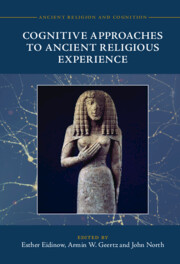Book contents
- Cognitive Approaches to Ancient Religious Experience
- Ancient Religion and Cognition
- Cognitive Approaches to Ancient Religious Experience
- Copyright page
- Contents
- Figures and Tables
- Contributors
- Abbreviations
- Funder Acknowledgement
- Introduction
- Part I Ritual
- Chapter 1 A Cognitive Approach to Ancient Greek Animal Sacrifice
- Chapter 2 To the Netherworld and Back
- Part II Representation
- Part III Gender
- Part IV Materiality
- Part V Texts
- Index
- References
Chapter 1 - A Cognitive Approach to Ancient Greek Animal Sacrifice
from Part I - Ritual
Published online by Cambridge University Press: 28 July 2022
- Cognitive Approaches to Ancient Religious Experience
- Ancient Religion and Cognition
- Cognitive Approaches to Ancient Religious Experience
- Copyright page
- Contents
- Figures and Tables
- Contributors
- Abbreviations
- Funder Acknowledgement
- Introduction
- Part I Ritual
- Chapter 1 A Cognitive Approach to Ancient Greek Animal Sacrifice
- Chapter 2 To the Netherworld and Back
- Part II Representation
- Part III Gender
- Part IV Materiality
- Part V Texts
- Index
- References
Summary
This chapter considers whether scholars should be seeking ‘meaning’ when considering animal sacrifice. Ritual activity that can be described as ‘normative Greek sacrifice’ is carried out in different circumstances with very different aims, for example to propitiate and honour a god or goddess, as part of the preparation of a meal, as a process to enable divination, or as a responsibility handed on by tradition. The various ritual actions that make up ‘normative Greek sacrifice’ – including burning incense, killing the animal, examining the entrails, eating the meat, and singing hymns and offering prayers – can be carried out outside the context of animal sacrifice. I make use of theories of ritualization to argue that ‘normative Greek sacrifice’ should be seen as a collection of actions to which those who take part in it bring their own intentions and therefore provide their own meanings. I then examine the sensory impact of these actions to show that they would have been emotionally satisfying in their own right. Finally I consider cognitive theories that might explain why ‘normative Greek sacrifice’ might have been transmitted in the form it was, and suggest directions for future research to provide answers to this question.
- Type
- Chapter
- Information
- Cognitive Approaches to Ancient Religious Experience , pp. 19 - 43Publisher: Cambridge University PressPrint publication year: 2022

